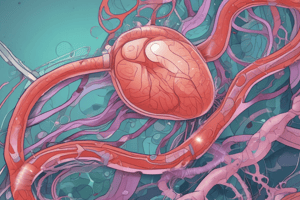Podcast
Questions and Answers
What is the function of zona pellucida in fertilization?
What is the function of zona pellucida in fertilization?
- Triggers the release of the blastocyst from the uterine lumen
- Facilitates the movement of sperm through the uterine tube
- Protects the zygote from maternal cellular defenses (correct)
- Provides nourishment to the conceptus
What is the initial site of fertilization in mammals?
What is the initial site of fertilization in mammals?
- The uterine lumen
- The ovarian follicle
- The upper region of the oviduct (correct)
- The uterine tube
Where does implantation occur in the female reproductive system?
Where does implantation occur in the female reproductive system?
- Vagina
- Cervix
- Ovarian follicle
- Uterine wall (correct)
What facilitates the movement of the developing embryo within the uterine tube?
What facilitates the movement of the developing embryo within the uterine tube?
What is the role of fertilization in providing nutrients to the conceptus?
What is the role of fertilization in providing nutrients to the conceptus?
Describe the process of fertilization in mammals.
Describe the process of fertilization in mammals.
Explain the role of zona pellucida in fertilization.
Explain the role of zona pellucida in fertilization.
What happens during implantation in the female reproductive system?
What happens during implantation in the female reproductive system?
How does the developing embryo move within the uterine tube?
How does the developing embryo move within the uterine tube?
What are the nutritive requirements of the conceptus during fertilization?
What are the nutritive requirements of the conceptus during fertilization?
Flashcards are hidden until you start studying
Study Notes
Fertilization in Mammals
- Fertilization occurs in the ampulla of the uterine tube, where sperm meet the egg.
- The zona pellucida, a glycoprotein layer surrounding the egg, plays a crucial role in fertilization by:
- Preventing polyspermy (multiple sperm penetration)
- Facilitating species-specific sperm recognition and binding
- Guiding the sperm to the egg's plasma membrane
- During fertilization, the sperm penetrates the zona pellucida, then the plasma membrane, and fuses with the egg's nucleus.
Implantation and Embryo Development
- Implantation occurs in the uterus, where the blastocyst embeds into the uterine lining (endometrium) approximately 6-7 days after fertilization.
- The developing embryo moves within the uterine tube due to the muscular contractions of the tube and the cilia-lined epithelium.
- During this time, the conceptus (fertilized egg) receives nutrients from the uterine fluids, which provide energy and support for early development.
Nutritive Requirements
- The conceptus relies on the uterine environment for nutrition, receiving essential nutrients, such as glucose, amino acids, and lipids, from the uterine fluids.
- The zona pellucida does not provide nutrients to the conceptus; instead, it facilitates fertilization and protects the embryo during early development.
Studying That Suits You
Use AI to generate personalized quizzes and flashcards to suit your learning preferences.




